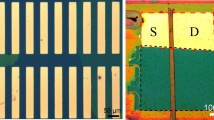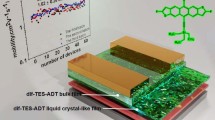Abstract
The organic single-crystal field-effect transistors using anthracene derivative, H-Ant as an active layer with source/drain electrodes decorated by metal charge transfer salt (CuTCNQ) were fabricated. We demonstrated that this bottom-contact structure displayed an obvious improvement in the electrical characteristics relative to their pristine copper and top-contact gold electrode counterparts. This observation could be ascribed to the lower contact resistance resulting from the energetic match between electrodes and semiconductor.
Similar content being viewed by others
References
Usta H, Facchetti A, Marks TJ. n-Channel semiconductor materials design for organic complementary circuits. Acc Chem Res, 2011, 44: 501–510
Chu CW, Chen CW, Li SH, Wu EHE, Yang Y. Integration of organic light-emitting diode and organic transistor via a tandem structure. Appl Phys Lett, 2005, 86: 253503
Di CA, Zhang FJ, Zhu DB. Multi-functional integration of organic field-effect transistors (OFETs): advances and perspectives. Adv Mater, 2013, 25: 313–330
Di CA, Liu YQ, Yu G, Zhu DB. Interface engineering: an effective approach toward high-performance organic field-effect transistors. Acc Chem Res, 2009, 42: 1573–1583
Dong HL, Jiang L, Hu WP. Interface engineering for high-performance organic field-effect transistors. Phys Chem Chem Phys, 2012, 14: 14165–14180
Ma H, Yip HL, Huang Fei, Jen AKY. Interface engineering for organic electronics. Adv Funct Mater, 2010, 20: 1371–1388
Chu CW, Li SH, Chen CW, Shrotriya V, Yang Y. High-performance organic thin-film transistors with metal oxide/metal bilayer electrode. Appl Phys Lett, 2005, 87: 193508
Di CA, Yu G, Liu YQ, Xu XJ, Wei DC, Song YB, Sun YM, Wang Y, Zhu DB, Liu J, Liu XY, Wu DX. High-performance low-cost organic field-effect transistors with chemically modified bottom electrodes. J Am Chem Soc, 2006, 126: 16418–16419
Frisch J, Glowatzki H, Janietz S, Koch N. Solution-based metal electrode modification for improved charge injection in polymer field-effect transistors. Org Electron, 2009, 10: 1459–1465
Whiting GL, Arias AC. Chemically modified ink-jet printed silver electrodes for organic field-effect transistors. Appl Phys Lett, 2009, 95: 253302
Kim WK, Hong K, Lee JL. Enhancement of hole injection in pentacene organic thin-film transistor of O2 plasma-treated Au electrodes. Appl Phys Lett, 2006, 89: 142117
Rentenberger S, Vollmer A, Zojer E, Schennach R, Koch N. UV/ozone treated Au for air-stable, low hole injection barrier electrodes in organic electronics. J Appl Phys, 2006, 100: 053701
Bock C, Pham DV, Kunze U, Kafer D, Witte G, Woll Ch. Improved morphology and charge carrier injection in pentacene field-effect transistors with thiol-treated electrodes. J Appl Phys, 2006, 100: 114517
Wu YL, Li YN, Ong BS. Printed silver ohmic contacts for high-mobility organic thin-film transistors. J Am Chem Soc, 2006, 128: 4202–4203
Liu SG, Liu YQ, Wu PJ, Zhu DB. Multifaceted study of CuTCNQ thin-film materials, fabrication, morphology, and spectral and electrical switching properties. Chem Mater, 1996, 8: 2779–2787
Liu YL, Li HX, Tu DY, Ji ZY, Wang CS, Tang QX, Liu M, Hu WP, Liu YQ, Zhu DB. Controlling the growth of single crystalline nanoribbons of copper tetracyanoquinodimethane for the fabrication of devices and device arrays. J Am Chem Soc, 2006, 128: 12917–12922
Jiang L, Gao JH, Wang EJ, Li HX, Wang ZH, Hu WP, Jiang L. Organic single-crystalline ribbons of a rigid “H”-type anthracene derivative and high-performance, short-channel field-effect transistors of individual micro/nanometer-sized ribbons fabricated by an “organic ribbon mask” technique. Adv Mater, 2008, 20: 2735–2740
Di CA, Wei DC, Yu G, Liu YQ, Guo YL, Zhu DB. Patterned graphene as source/drain electrodes for bottom-contact organic field-effect transistors. Adv Mater, 2008, 20: 3289–3293
Pang SP, Hernandez Y, Feng XL, Müllen K. Graphene as transparent electrode material for organic electronics. Adv Mater, 2011, 23: 2779–2795
Natali D, Caironi M. Charge injection in solution-processed organic field-effect transistors: physics, models and characterization methods. Adv Mater, 2012, 24: 1357–1387
Yoon MH, Kim C, Facchetti A, Marks TJ. Gate dielectric chemical structure-organic field-effect transistor performance correlations for electron, hole, and ambipolar organic semiconductors. J Am Chem Soc, 2006, 128: 12851–12869
Wang SD, Minari T, Miyadera T, Aoyagi Y, Tsukagoshi K. Bias stress instability in pentacene thin film transistors: contact resistance change and channel threshodl voltage shift. Appl Phys Lett, 2008, 92: 063305
Wang SD, Yan Y, Tsukagoshi K. Understanding contact behavior in organic thin film transistors. Appl Phys Lett, 2010, 97: 063307
Weis M, Lin J, Taguchi D, Manaka T, Iwamoto M. Insight into the contact resistance problem by direct probing of the potential drop in organic field-effect transistors. Appl Phys Lett, 2010, 97: 263304
Tang Q, Tong Y, Li H, Ji Z, Li L, Hu W, Liu Y, Zhu D. High-performance air-stable bipolar field-effect transistors of organic single-crystalline ribbons with an air-gap dielectric. Adv Mater, 2008, 20: 1511–1515
Di CA, Yu G, Liu YQ, Guo YL, Sun XN, Zheng J, Wen YG, Wu WP, Zhu DB. Selective crystallization of organic semiconductors for high performance organic field-effect transistors. Chem Mater, 2009, 21: 4873–4879
Author information
Authors and Affiliations
Corresponding authors
Rights and permissions
About this article
Cite this article
He, L., Ji, D., Wang, E. et al. Modulating the metal/organic interface via CuTCNQ decorated layer toward high performance bottom-contact single-crystal transistors. Sci. China Chem. 58, 1027–1031 (2015). https://doi.org/10.1007/s11426-014-5240-6
Received:
Accepted:
Published:
Issue Date:
DOI: https://doi.org/10.1007/s11426-014-5240-6




